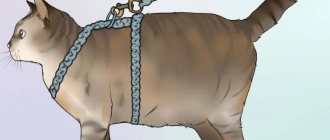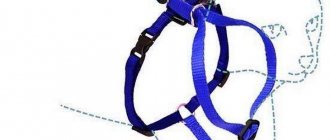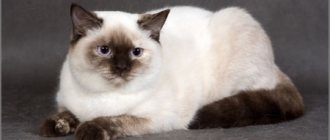Cats have always been considered energetic, active and agile animals. Now many of them spend months in their apartments, dreaming of frolicking in the fresh air. Some owners worry that the cat might get lost in a big city if they take it for a walk.
But there is a way out - you can buy a harness for cats in any store. A harness is a leash of a special design, thanks to which you can walk your pet without carrying it and not worry at all that it will run away. Cat harnesses come in different sizes and designs: the owner needs to choose the best option.
When a cat harness comes to the rescue
A cat harness comes to the aid of owners who plan to take their pet out of the house to the street or to an unfamiliar place. A design with a collar and leash is used to keep the animal within sight, prevent it from running far, hiding in a secluded place unknown to the owner, or climbing a tree, from where it will be extremely difficult to get it out.
Harnesses are used for both kittens and adult pets, the only difference is in size. A cat leash will be useful at exhibitions or when visiting a veterinary clinic - with it the animal will be under the full control of the owner, not immobilized, but safe.
What is a harness and why is it needed?
A strap is 2 straps, fastened together, which are put on the chest and capture the upper abdomen. In the area of the shoulder blades there is a mount to which the leash is attached. Each strap that makes up the product has buckles, so the harness can be perfectly adjusted to the size of the animal. Most often, the accessory is used during a walk to prevent the animal from running away. In addition, the harness is used for bathing, when the animal is fixed with a leash on a suction cup, which is attached to the bathtub. The cat wash fixative is also suitable for water procedures. Straps are also necessary when visiting an exhibition or a veterinary clinic.
In what cases is it prohibited to lead a cat on a harness?
A cat on a harness has the opportunity to walk outside - this is a definite plus. However, not all cats need walks, and sometimes they are completely contraindicated.
Cat harnesses themselves do not pose a danger to the animal - except in cases where there are severe wounds or sores on the skin. Leash straps can rub the sore spot, delaying healing and causing infection. Therefore, you should not walk with your pet until the wounds on the skin have healed completely.
Walking, with or without a leash, is contraindicated in several cases:
- During the period of heat, it is better to refrain from leaving the house.
- After serious operations or injuries, according to the veterinarian, it is necessary to reduce the number of walks or abandon them altogether.
- In the absence of vaccinations, it is better not to take the cat outside or to the dacha - a pet with low immunity can easily contract a dangerous disease, even if it just sniffs a blade of grass.
- Until the kitten reaches the age of 5-6 months, it is better to refrain from walking.
- If a cat is terrified of the street, there is no need to force it to walk - many mustachioed cats are content with walking on the balcony or looking at the outside world through the window.
The list goes on for a long time; There are several reasons for refusing to go for walks. If your cat doesn't feel well or wants to sleep on the sofa, you shouldn't give him a walk - this will bring extra stress.
A harness is an indispensable accessory for walking.
To ensure that the cat's walks are safe, the owner must purchase a special harness. It consists of two collars, the first of which covers the neck, and the second – the body. The latter is attached to the pet's stomach. The first collar has a ring for a leash, located exactly between the shoulder blades. Thanks to this arrangement, the pressure on the animal's spine is reduced.
The harness and leash are usually included in one set. The length of the leash can be easily adjusted, so that the animal can be released to the required distance. If force majeure occurs, such a design will be very useful.
Types of accessory
A harness on a cat is a guarantee of a free and safe walk. To make your cat feel comfortable and not slip off the leash, you need to choose a model that is suitable in size and design. Before you go shopping for a cat harness, look at photos of existing types - this way you will decide in advance on the purchase by at least 50%.
Eight
A figure-of-eight harness for a cat consists of two loops attached to the neck and front paws. The straps hold the animal's body tightly, eliminating the possibility of escape.
Vest
A vest, or jacket, is a hybrid of clothing and a leash for walking. This harness is worn on a cat in cool weather - it will save the pet from dirt and cold. The downside of a vest harness is that the cat may not like it because it’s too tight.
H-shaped
This variation is similar to the figure eight. The only difference is that the two loops on the back do not cross, but are secured with a transverse bar, thereby becoming similar to the letter “H”.
V-shaped
The loop of such a harness on the cat’s chest is folded into the letter “V”. On the back it looks like a figure eight or H-shaped design. There is no fundamental difference.
Quick release harnesses
Such designs have only one clasp, which snaps onto the pet’s back. They are made from strong nylon.
Popular models:
- Ferplast Easy Easy Small. Available colors: red, brown, orange, black, blue, pink. Chest circumference – from 35 to 56 cm.
- Doo S. Color red. A special feature of the model is the presence of LEDs. Suitable for pets with a chest circumference of 30-42 cm. The width of the straps is 2 cm.
- Zoonic set with leash. Available colors: brown and green. Belt width – 1 cm.
- Saival classic XXS. Colors: red, yellow and black. Suitable for small cats or kittens with a chest circumference of 17 to 27 cm.
- TRIXIE Premium with leash. Purple harness, universal for all cats. Suitable for medium sized animals.
These models are very easy to use. They fasten quickly, are conveniently adjusted and eliminate the possibility of escape.
IMPORTANT! You should pay attention to the presence of a belt that goes between the front legs along the chest. Without such a strap, the cat's throat will be compressed.
How to choose a model and size
Don't rush to purchase the product right away. The ideal option would be to buy a harness with your pet, but if this is not possible, pay attention to the following nuances:
- the optimal material is cotton or nylon, the fabric will not rub the animal’s body and get very dirty;
- 1.5 centimeters is the ideal width of the straps, since a wider version will restrict the pet’s movements, and a narrower one will rub and tighten;
- fastenings should be easy to unfasten and fasten - this guarantees the durability of the device;
- Is there a mechanism for attaching a leash?
If you come shopping with your pet, be sure to try on the harness you like on your cat. Whether it fits or not can be determined by inserting 2 fingers between the strap and the back of the animal. If your fingers were able to pass freely, then the choice was made correctly.
The choice of harness model for a cat depends on its size and, oddly enough, temperament. If the cat is large or restless, buy a reliable option - a vest or V-shaped harness. For calm and small pets, figure-eight or H-shaped modifications are suitable.
A leash is immediately purchased in the kit; it is connected to a special ring and reaches a length of approximately 2 meters. You can find a leash of a different length or buy a tape measure. The last option is suitable for those who have chosen a vest-style harness for their pet, already equipped with fasteners. But be careful: you shouldn’t walk in the heat in a vest.
Some models are made to make the cat look fashionable - they are decorated with rhinestones, ornaments, and pendants. Such accessories are suitable for participating in various competitions and creating original photos, but they are not always convenient and safe for the animal. Therefore, choose elegant harnesses and leashes for your cat with caution.
Harnesses-vests
Such products look like a soft vest that covers half of the body. They are very comfortable for cats as there is no pressure from the straps. For their manufacture, soft porous fabric is used.
Popular models:
- Triol S with leash. Colors: brown, yellow, blue, crimson. The material is well ventilated, as it has small holes. Chest volume – 35 cm.
- Petkit AIR FLY S with soft lining. The harness has a perfect fit thanks to the unique 3D fit. The material is elastic, breathable, and has a reflective element. Suitable for large cats with a chest volume of 45-50 cm.
- Marvelous Dog S. Gray-pink color. The entire internal surface is made of soft mesh material. There are special adjustable straps, thanks to which you can adapt the harness to a specific animal. Bust circumference – 36-48 cm.
- Petkit Air Pro XS. Color dark gray. The model has an ideal and very comfortable shape. There is a foam padding sewn inside that has a shock-absorbing effect. There is also a reflective element. Chest circumference – 40-45 cm.
- Puppa Soft vest harness pro S. Colors: black, blue, light brown, khaki, yellow, green, orange, red, pink, dark blue, purple. The harness is made of breathable material. Suitable for small pets with chest volume from 30 to 32 cm.
This type of harness has a great advantage - if the size is chosen correctly, the cat will not be able to get out of it and run away.
INTERESTING! Some models are equipped with reflective tapes.
How to put a harness on a cat
A harness for walking a cat must be comfortable for the owner and the animal itself - otherwise the pet will flatly refuse to wear it.
Before you put the harness on your cat, it must be assembled correctly. It is best to do this following the advice in the attached instructions. The design should not contain twisted straps or sharp protruding elements.
Next, in several stages,
the owner introduces the cat to the accessory and eventually puts it on:
- It is necessary to let the cat sniff or even play with the harness. Even if this is not the first time he goes for a walk, it is important for him to understand that the object will not cause harm or inconvenience.
- Before putting a harness on a cat, you need to take the pet in your arms and calm it down.
- One loop is placed around the cat’s neck so that the carabiner is on top, and the animal’s paws are inserted into the second loop and the straps are adjusted. The harness should fit snugly on the cat, but not tight.
- Make sure that nothing is twisted and does not cause discomfort to the cat. If your pet meows, most likely something is painfully pressing on him.
- The leash is the last thing to be attached to the ring. Next, the structure is checked for reliability of fastenings.
A cat wearing a harness should feel comfortable and calm, the straps should not put pressure, rub or restrict movement, so it is necessary to select an accessory strictly according to the size and individual parameters of the pet.
Of course, all animals react differently: some perceive the innovation calmly, others diligently try to remove the straps. If you see that your pet is uncomfortable and is trying to get rid of the accessory, then you need to distract him with something. For example, give him a favorite treat or play with him.
Strengths and weaknesses of the harness
Among the advantages of cat products are the following:
The use of a harness allows the owner to control the pet without restricting its movements.
- They securely secure the pet, allowing the owner to control it.
- They have several types, which are suitable for kittens and large cats.
- They do not restrict the animal’s movements if the size is chosen correctly.
- The load is distributed on the chest and not on the neck, which prevents asphyxia if the pet gets caught.
- Some types of harnesses are easy to wash if the cat gets it dirty.
Among the disadvantages, breeders see the following:
- The cat can independently remove the harness if it is of poor quality, break free and run away.
- Causes allergic reactions when the materials of the product are of dubious quality.
- Long-haired cats develop mats when straps are used for a long time.
- Stress when it comes time to put on the product.
Training and walking rules
Accustoming to a harness should happen gradually, the ideal age for this is from six months to a year. Another option is to train a kitten at the age of 3 months, but without walks, at home. The older the cat, the longer the habituation process will take.
Let the kitten “get acquainted” with the new object: let him think that this is his new toy. Let your baby sniff, play, or just be nearby—you don’t need to put on the accessory right away. Let the harness lie near your pet’s favorite and frequent places: near the tray, bed, bowl. After a few days, you can try to carefully put the harness on the cat, but only without a leash and not for long! Let your pet get used to it gradually.
The optimal time for getting used to is 5-10 minutes. It is better if the short-term procedure is repeated more than once. Make time for exercise before meals and then feed your pet - then your cat will associate it with something pleasant.
After some time, you will see that the cat feels comfortable with the harness and does not even notice it. This means it’s time to fasten the leash and start pulling it with light movements. You should not get carried away - you will only harm or scare the pet, and the cat will begin to rest its paws and free itself.
Try to do what the animal wants: run with it, wait, just be close, and soon the pet will get used to it. When the cat is completely comfortable, you can go outside with a leash.
Instructions: how to wear the accessory?
The process of putting on a harness should not frighten the animal; all movements are recommended to be done smoothly and easily.
You need to collect the animal for a walk and put on a harness in this way:
- Pet your pet and talk to it affectionately.
- Unfasten the leash and check that the straps are not twisted.
- Place the cat in front of you and put the front part of the harness on your chest.
- Carefully lift the front legs and thread them into the second part of the product.
- The leash should be attached after the harness is put on and straightened.
Pet leash pattern
Cats love walks just as much as dogs, but they have much worse problems with obedience. Therefore, not a single owner will let a cat out in a park or square, and not everyone has a dacha. Is it really because of this that cats are doomed to sit within four walls and greedily inhale fresh air through a narrow crack in the window?
Of course no. You can take a cat for a walk in the same way as a dog on a leash. You just need a special leash.
What's best for a walk?
An owner who decides to take his pet outside for the first time has to make a difficult choice. Of course, you can carry a cat in your arms and let it go in a quiet place, but the likelihood that the animal will get scared of something and fly up a tree like a bullet is very high. Despite the belief that cats are excellent at climbing trees, not every cat can climb down on its own.
It is much easier to restrain the cat so that it cannot run far. When choosing between a leash and a harness, you should choose the second one, because the cat’s neck is thin and fragile. It is very easy to injure her with a collar. And if you don’t tighten it tightly enough, the animal will simply wriggle out of it, leaving an empty collar in the owner’s hands.
If you plan to walk your cat constantly, then you need to teach it to get ready for a walk from early childhood.
In this case, the animal will not have stress from an unfamiliar place and from putting a strange object on it. Don’t forget that cats are quite freedom-loving and rarely tolerate experiments on themselves.
An easy way to sew a harness
You can buy a harness at any pet store, but if you start training with a kitten, then finding the size for the cat is not easy. It's easier to sew it yourself. And given that the kitten will grow up quite quickly, the cost of purchased equipment will be high. A homemade harness for a cat will be a source of pride for the owner.
Sewing a harness at home is quite simple. To do this, you will need straps or a special tape, which can be bought at any store that sells everything you need for sewing. You will also need to buy a couple of fasteners and a ring to which the leash will cling. And for the leash itself you will need a small carabiner. It can be purchased or removed from a handbag.
Instructions
In order to sew a harness from straps, you need to measure the animal’s neck with a measuring tape. When measuring, you cannot press the tape tightly, since your finger should fit freely between the animal’s neck. You need to add about 2 cm to the measurements for allowances.
The second measurement is taken behind the front legs. Here you will need to secure the clasp, so the length can be made taking into account that the animal may gain a little weight. The strips must be fastened together by crossing at the cat's withers. A ring for a leash is sewn into the same place.
Another strap will run across the animal's chest and connect the other two so that the cat's paws are secured and the pet does not twist out of the harness.
The first strap that will wrap around the neck can be made solid, or you can attach a clasp to it. This will allow you to fasten the neck strap tighter, because if it is without a fastener, you will have to put it on over your head.
The second version of the harness involves the use of a pattern and thick fabric. You can use a piece from old jeans.
How to save money?
This is also very simple. The leash can also be made from a long and strong ribbon or stitched together a strip of fabric. A cat is not strong enough to break a strong leash, but if you are planning to walk in a large area, then you should think about a leash of a couple of meters. You need to make a loop on one edge so that you can put it on the wrist, and firmly sew a carabiner on the other edge.
Top articles: Woodcock
We knit a harness
The harness is knitted according to the same principle. Change the girth of the neck and the girth behind the front legs. Only in the case of knitting, it is necessary to take into account that the measurements must be as accurate as possible, since in this case there is no way to adjust the harness with clasps.
The easiest way to knit a harness is to crochet. The procedure is simple and even those who have recently picked up yarn can handle it. If necessary, you can watch the video on the Internet.
Decor
- Any owner wants his pet to be the most beautiful. In truth, cats don't care what the harness is decorated with, but owners love to create unique things.
- You can sew various beads onto the harness, glue rhinestones and sequins. The main thing is that they are securely fastened, and the pet cannot chew them off.
- Otherwise, the animal may swallow the bead and get many health problems.
Preparation
We have discussed all aspects that require special attention. Now we begin to prepare for the walk itself.
Vaccination and treatment against parasites
Pets cannot be taken outside without vaccinations. Even a strong immune system cannot cope with serious diseases. Unfortunately, many owners believe that their place of residence is safe, which means they don’t have to spend money on things like vaccinations and anthelmintic drugs. However, just walking on the grass, a cat can pick up fleas, ticks and even helminths!
Warning! By ignoring vaccination and treatment against parasites, the owner jeopardizes not only the health of the animal, but also the health of his family members. Our little brothers can contract many dangerous diseases if they are not given routine vaccinations.
Residents of the southern regions should be especially attentive to the issue of vaccination. The tropical climate (or rather, high levels of humidity) is a favorable environment for various viruses and bacteria, for example, leptospira, which causes leptospirosis. If the owner plans to spend a vacation by the sea, taking the cat with him, it is necessary to check with the veterinarian what additional vaccinations may be needed.
Collar
Cat collars serve a certain practical purpose. For example, this is a necessary accessory at exhibitions or while walking. You can hang an address tag on the attribute in case your pet gets lost. Reflective collars help you find your pet in the dark.
What types can be found on pet store shelves:
- with GPS navigator;
- with a bell and other decorations;
- decorative (for exhibitions and photo shoots);
- antiparasitic.
Walking a cat on a leash and harness
Leash
In urban conditions, walking a cat is strictly on a leash. Walking with a cat is completely different from going outside with a dog.
To control all movements you need a strong leash. Without it, the owner will not be able to provide his household with a safe stay on the street outside the home.
This accessory is not necessary if the pet lives in a private sector and has constant access to the street, i.e. prefers to walk on his own.
Harness
Purebred individuals regularly attend regional and international exhibitions. For the safety of transportation and control of the pet, ammunition is purchased.
A harness is the best option for both outdoor walks and long trips. With its help, the owner can control the cat. Few mustachioed purrs know commands and do not run away from their owner in search of adventure.
What makes the accessory unique? It is made of special thin straps that wrap around the body behind the shoulder blades and have a fastener at the level of the back/chest. At the same time, the design does not create uncomfortable sensations and does not provoke a stressful state.
Let's look at the harness models:
- in the form of a vest (mesh material allows the skin to breathe);
- with an additional strap at neck level (considered the most reliable);
- standard (straps).
Contraindications to using a harness
Sometimes walking with a cat, even in a harness and on a leash, is not always possible. There are situations when it is better to avoid walking, namely:
- A kitten should not be taken for a walk when it is less than 5 months old. At this age, he has not yet received an anti-infectious vaccination, so walks can end in unpleasant consequences.
- For some time, they refrain from walking cats that have been sick for a long time, have had surgery, and need rehabilitation.
- If the cat is shy or nervous, then it is better not to take it out for a walk at all, even when using a harness with a leash. Such a walk will be more harmful than useful. Stress can weaken her immune system and cause heart disease. It is better for such animals to walk on the windowsill in the apartment.
- When a cat who has lived in the house for a long time has never been outside, it is not worth teaching him to go for walks on the street. His condition may worsen.
- If a cat is in heat, she is expecting offspring, and she should not go for walks either.
Walks taken in the above cases can result in stress for the animal and have a detrimental effect on its health.
Instructions for making a collar for a cat with your own hands
A collar with a name tag will help you find your pet if it goes missing. To make it, you will need the following devices and materials:
- old belt with buckle;
- blank for a medallion with a loop (if there is no loop, it will have to be drilled);
- a tight ring, preferably made of steel;
- steel plate;
- mounting tape;
- pencil;
- hammer;
- permanent marker;
- alcohol;
- bits with the required letters and numbers.
Then you need to put the bat in the middle and carefully hit the top with a hammer several times. To prevent the letters from blending into the background, they should be covered with a marker, having previously degreased the surface with alcohol. Once the medallion is ready, it must be attached to the ring and secured to the strap
Once the medallion is ready, it must be attached to the ring and secured to the strap.
On the medallion you can place the cat's name, phone number and address of its owner. In this case, it is advisable to place the animal’s name on the front and information about its owner on the back. It is recommended to remove the collar periodically to prevent creases from forming on your pet’s fur.
The simplest collar option for cats with free access to the outdoors is a product made from a nylon sling. To make it at home you will need to take the following materials:
- nylon sling;
- colored ribbon with ornament;
- plastic clasp and buckle;
- half ring
First you need to use a sewing machine to sew the tape to the sling (stitch length - 2 mm).
Then you need to attach the fastener by unfastening it and threading it through one of the elements of the end of the sling. It needs to be folded and sewn to the base of the collar at the fold.
The free end must be threaded through the ring, moving it closer to the beginning. Then it needs to be stitched again across the sling, using the material that was threaded through the fastener to secure the half ring.
Then the end of the sling needs to be slightly bent back and stitched across to secure the buckle.
From the prepared piece of fabric we form 3 blanks. The size of the parts is shown in the picture. The longest part from which the collar will be made should be equal in length to the circumference of the animal’s neck, so you need to take measurements in advance
Please note that the butterfly collar should not put pressure on the cat's neck. Blanks for needlework Let's start creating the butterfly itself. To do this, fold the edges of the largest rectangle towards the center and iron its fold lines
The workpiece should take the shape you need. We work on a large rectangle We repeat the same steps with a small rectangle measuring 5x7 cm. We fold both parts horizontally in half and make a seam at a distance of 5 mm from the edge. We use a sewing machine and turn the pieces inside out so that the seam remains hidden from the inside. We thread the larger piece through the smaller one. The butterfly is ready. Finalizing the butterfly Let's move on to creating the collar itself. Fold the elongated third rectangle, smoothing its edges towards the center. We sew Velcro to the ends of the collar. We make the seam vertical. We form the collar for the cat. Carefully thread the collar through the ring of our butterfly. Putting the details of our work together
To do this, fold the edges of the largest rectangle towards the center and iron its fold lines. The workpiece should take the shape you need. We work on a large rectangle We repeat the same steps with a small rectangle measuring 5x7 cm. We fold both parts horizontally in half and make a seam at a distance of 5 mm from the edge. We use a sewing machine and turn the pieces inside out so that the seam remains hidden from the inside. We thread the larger piece through the smaller one. The butterfly is ready. Finalizing the butterfly Let's move on to creating the collar itself. Fold the elongated third rectangle, smoothing its edges towards the center. We sew Velcro to the ends of the collar. We make the seam vertical. We form the collar for the cat. Carefully thread the collar through the ring of our butterfly. Putting the details of our work together
A charming fabric butterfly collar will become a worthy accessory for your pet. An elegant decoration will come in handy on holidays or special occasions.
We're going for a walk
There are two ways to teach dressing, both using the method of positive associations. Screaming and violence will only undermine the pet’s trust.
Treat your purr to his favorite food when you put on his harness or engage him in play. The cat will get used to the smell and learn that it is rewarded when it is dressed. Then the time of contact with the ammunition is extended.
When the cat behaves calmly, without showing anxiety or trying to remove the harness, and stays in it for a long time, you can get ready to go outside.
The first walk always takes place in uncrowded places, with a minimum number of distractions. The cat can be taken outside in a carrier.
Don't pull on the leash to get him out of her. Offer a treat if the animal refuses to eat or play - it means it is stressed. Wait a while, if the condition does not change, then for the first time it is enough.
Cats, cats, kittens - have their own character, fears, and are subject to mood. Be patient and it will be rewarded. There is nothing better than a carefree walk in the company of a purring dog.
Types of collars
Choosing a collar for a cat depends on the goals you pursue when choosing. In addition to anti-parasitic (protective), calming (for nervous and aggressive pets) and beautiful decorative collars, there are other types that help not only safely walk your pet, but also track its location:
- self-release collars for walking are the safest type. If the animal gets into a situation in which the collar can play the role of a noose, the structure stretches and frees the pet;
- personal accessories with addresses and names - in case of loss of a pet, a personalized collar with information will help quickly bring the animal back;
- GPS collars - a kind of cat navigator - will not be cheap. However, it will not only be suitable for those who do not want to limit the pet’s freedom of movement, but will also help track its location in case of loss;
- collars with bells - this accessory will help you determine by sound whether your pet is within reach. And will warn other pets about the approach of a small predator.
How to do it yourself
You can make a neck collar for a pet yourself if you suddenly need such a collar urgently, but you can’t buy it or the store doesn’t have the appropriate size. The simplest materials are suitable for this: cardboard, plastic, dense material.
From fabric
The advantage of a fabric collar is its softness; it serves as a pillow for the cat. But if she tries to take it off, make a tougher option. For self-production you will need: tape measure, scissors, material, marker, stapler, tape.
Step by step steps:
- Take two measurements: the first is neck circumference; the second is the length of the head (from the collar to the tip of the nose).
- Make a template out of paper, draw an inner semicircle with a compass, which corresponds to the first measurement, retreat to the distance of the second, mark the outer semicircle. Add an extra 2.5 cm for seams.
- Cut out the paper pattern according to the dimensions.
- Cut out two parts of the product onto the fabric.
- Proceed with assembly.
- Fold the right side out, place a piece of cardboard between the pieces of fabric, connect, sew the two halves together.
- Instead of cardboard, you can use another dense layer: felt, non-woven fabric, and sew all the blanks together with a diamond-shaped seam.
- Connect the edges with Velcro.
- Make lacing from fabric or, better yet, from flexible plastic on the inner edge to secure it to the animal’s neck.
Sew a thick fabric border along the outer edge. Another option is to buy a plastic collar and adjust the dimensions according to the dimensions of the animal. Then sew on thick soft fabric.
From the bottle
The product will be flexible and durable, the protective barrier will last a long time. For this you need: a plastic bottle of a suitable size, tape, adhesive tape or string. First take your measurements. Then cut out the parts from paper. Cut out a cone according to the paper diagram. Make holes using a nail or a thick needle.
Second way:
- On the side of the neck, mark with a marker a diameter equal to the circumference of the cat’s neck.
- Cut off this part and measure the length of your pet's head.
- Cut off the remaining plastic.
- Cut lengthwise and try it on the animal.
- Make holes along the cutting line and thread lacing made of soft fabric.
You can secure the Velcro fastener with a stapler. Cover sharp cuts with adhesive tape or tape.
Quick option
For an emergency, a cardboard cone is suitable, although it is not intended to last for a long time. Instructions:
- Prepare thick cardboard (shoe boxes, household appliances).
- Take measurements from the animal.
- Mark them on cardboard.
- Cut according to the design with scissors.
- Wrap the edges of the structure with tape.
- Secure the cone parts with adhesive tape.
- Make loops for the collar.
This method is suitable when the animal has not yet recovered from anesthesia.











